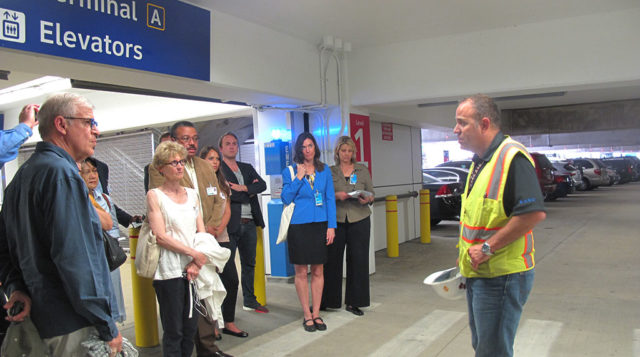Uncovering the Complexity of Global Air Hubs
July 3, 2014 — Blog
During the closing session of the NewCities Summit in Dallas last month, the Mayors of Dallas and Fort Worth, Mike Rawlings and Betsy Price, both praised Dallas/Fort Worth International Airport as a mutually profitable exercise in “coopertition” – an intelligent mix of cooperation and competition. Both mayors are board members of this 40-year old economic engine that in 2013 brought in $36 billion of revenue and sustained 143,000 jobs in the Dallas-Fort Worth metroplex.
The travel-weary usually aim to speed through rather than study airports, so what could be interesting about a visit? Lots, as those of us who had opted for a site visit to DFW on day three of the Summit discovered. And the folks at DFW International efficiently and engagingly made sure we studied on the run.
Over coffee and bagels in the Fire Department’s Training HQ, the heads of DFW’s 26 square miles of services and operations gave us the 30,000 feet view of how the world’s third busiest airport (in operations) handles cargo – self-loading and otherwise.
After the warm welcome and with boarding passes in hand, we stepped into the blinding, stifling heat of the Texan morning sun. The hot breeze didn’t help. Neither did the furnace-like blast from the (controlled) flames that engulfed the A380 super jumbo model. But wow, it was exciting! We looked on as the firefighters demonstrated the ever more complex science of tackling fires on today’s planes of many sizes, materials and electronic systems. These dedicated and brave teams are taught how to swim against the tide – they climb into the fire to make sure we get out. A small sign at the car-park exit reminded us that the burden of responsibility is big: “Mistake’s made, learn from it, leave it at the gate”.
Our route to the terminals took us through the cargo and maintenance hubs. Who knew that US helicopter blades rotate counter-clockwise and European ones clockwise. And that DFW airport has test facilities for both. Or that 16 cargo carriers made a $16 billion positive impact on the region’s 2013 budget. Or that the webcam enabled pet day-care center lets you to keep an eye on pooch whilst you’re apart.

Next stop, DFW’s inner transport hub of parking and mass transit. The soon-to-be-opened light-rail station at the end of the Dallas Area Rapid Transit’s orange line will ultimately feed passengers straight into airport terminals from Fort Worth’s T transport system and Dallas’ DART (Dallas Area Rapid Transit). Driving in? Tell your phone where you’re flying and it’ll guide your car to the best parking spot (app coming soon). But will it also help you find it again?
Once airside we whizzed between terminals on the Skylink airport transit system, stopping at stations along the way to meet more of the people who manage the finely-tuned supply chain that is DFW International. Airport terminals are the equivalent of city town squares – lively multi-cultural spaces ringing with many languages. DFW uses technology and its multi-million dollar public art program to make everybody feel at home. Next time you’re in Terminal D, walk round (and round) the ‘Circling’ maze and solve the puzzle. According to our art guides, only three ever have (and none of them us)!

Our final destination was lunch hosted in DFW’s former international passenger transit area that was closed off following the events of September 11, 2001. It straddles the air- and land-side divide and provoked an interesting discussion about the complex security operations that protect the safety of the airport’s employees and passengers (16 million of them last year).
Our morning was a sea of statistics, but thanks to our hosts they very clearly described the complexity, impact and importance of a facility we tend to rush through, heads down, towards our final destination.